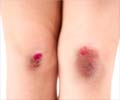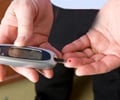
‘In diabetic wounds, the naturally occurring electrical signal is impaired, which slows down the healing process.’
Tweet it Now
It has been estimated that as much as $25 billion a year is spent on treating chronic ulcers and wounds related to diabetes, Zhao said. Electric Fields and Wound Healing
Electric fields are associated with the living tissue. Previous work by Zhao and Brian Reid, project scientist at the UC Davis Department of Dermatology, showed that electric fields are associated with healing damage to the cornea, the transparent outer layer of the eye.
In the new work, published in the journal Scientific Reports, Zhao, Reid and colleagues used a highly sensitive probe to measure electrical fields in the corneas of isolated eyes from three different lab mouse models with different types of diabetes: genetic, drug-induced and in mice fed a high-fat diet.
In a healthy eye, there is an electrical potential across the thickness of the cornea. Removing a small piece of cornea collapses this potential and creates electric currents, especially at the edges of the wound. Cells migrate along the electric currents, closing the scratch wound in about 48 hours.
Advertisement
"We saw similar results with all three models," Reid said.
Advertisement
The UC Davis bioelectricity laboratory is one of a very few able to make such sensitive measurements of electric fields in living tissue.
"We might be the only lab in the country that is able to do this," Reid said. They are collaborating with a number of laboratories worldwide and across the country, as well as several other UC Davis departments.
Source-Eurekalert















